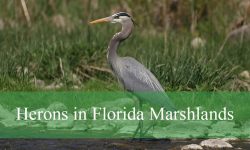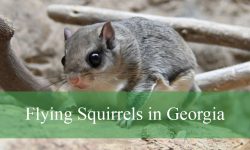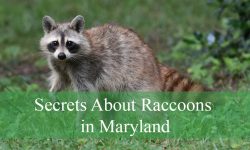Vermont’s diverse forests, wetlands, and open meadows make it a haven for birdwatchers throughout the year. From vibrant warblers in spring to hardy woodpeckers in winter, the variety of birds in Vermont offers something for every nature enthusiast. Scanning the skies over Lake Champlain or walking a quiet forest trail, you’re likely to spot some truly remarkable species.
Birds in Vermont range from the bright yellow American Goldfinch to the hauntingly beautiful Common Loon. Some, like the Red-tailed Hawk, soar high above open fields, while others, such as the White-throated Sparrow, hide among dense undergrowth. This rich diversity reflects the state’s mix of habitats and changing seasons, attracting both year-round residents and migrating birds.
This guide presents 25 common birds in Vermont, complete with descriptions and identifying features to help with spotting them in the wild.
Different Types of Birds in Vermont
American Robin
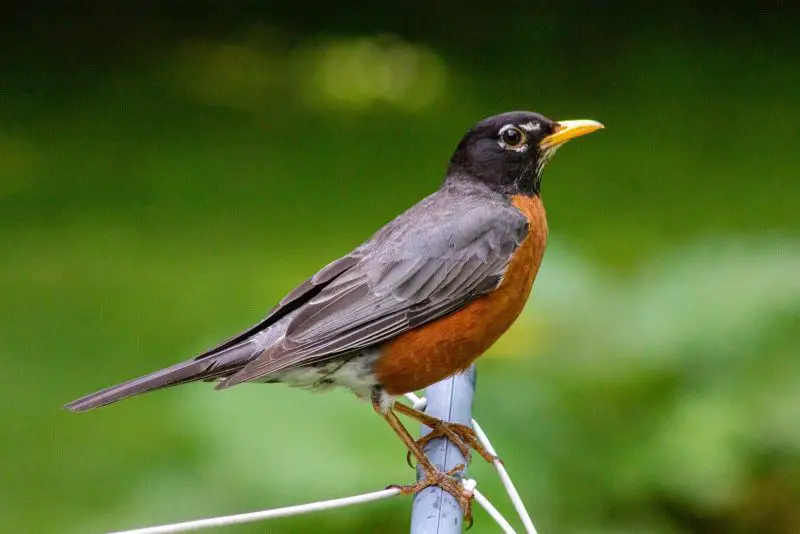
The American Robin is Vermont’s state bird and a familiar sight in neighborhoods, gardens, and open fields. It’s easily recognized by its warm orange belly, gray back, and bold white markings around the eyes. Measuring about 9 to 11 inches in length, it has a plump body, long legs, and a straight yellow bill.
This bird is known for its melodious, flute-like song, often sung at dawn and dusk. Robins are active foragers, frequently spotted hopping across lawns in search of earthworms. They are among the first birds to sing in the spring and are associated with the arrival of warmer weather in Vermont.
American Robins are widely distributed across the state, inhabiting woodlands, farmland edges, parks, and suburban areas. They are migratory, typically returning to Vermont in early spring and remaining until late fall, although some individuals may overwinter in sheltered locations with access to food.
Black-capped Chickadee
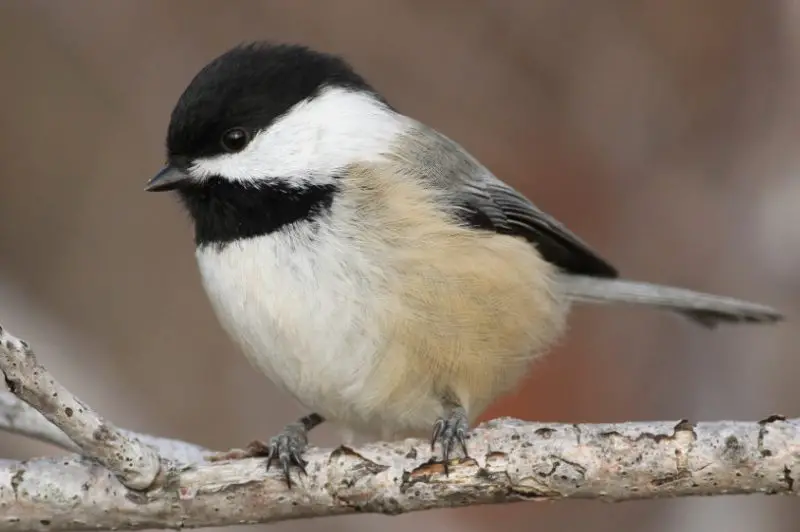
The Black-capped Chickadee is a small, round-bodied bird that brings energy and curiosity to Vermont’s forests and feeders. It has a black cap and bib, white cheeks, and soft gray plumage on its wings and back. Adults are about 5 inches long, with a short bill and a relatively long, rounded tail.
This species is especially vocal, known for its namesake call: “chick-a-dee-dee-dee,” which changes in intensity depending on threat levels. Another distinctive sound is its sweet, whistled “fee-bee” song, heard throughout the year. Chickadees are social and acrobatic, often forming flocks in winter and inspecting every nook for food.
In Vermont, Black-capped Chickadees live year-round in mixed and deciduous forests, swamps, and backyards. They readily visit feeders for sunflower seeds, especially during colder months. Their ability to store food and remember its location helps them survive harsh winters in the region.
Tufted Titmouse
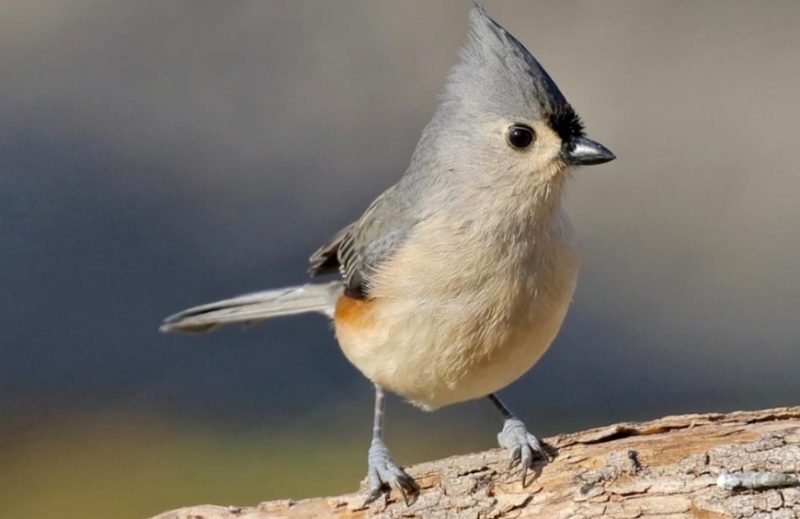
The Tufted Titmouse is a charming bird often seen flitting about woodlands and backyard feeders in Vermont. It is medium-sized for a songbird, about 6 to 7 inches in length, and features soft gray plumage, a white belly, rusty flanks, and a prominent gray crest that gives it a curious and alert appearance.
This bird communicates with a variety of vocalizations, including its clear, whistled “peter-peter-peter” song. Tufted Titmice are active and agile, frequently seen hanging upside down from branches as they search for insects and seeds. They are often found in mixed flocks with chickadees and nuthatches, especially in winter.
Tufted Titmice are found year-round in southern Vermont and have gradually expanded northward. Their preferred habitats include deciduous woodlands, suburban neighborhoods, and parks with mature trees. They frequently visit bird feeders, particularly those offering sunflower seeds and suet.
Northern Cardinal

The Northern Cardinal is one of the most visually striking birds in Vermont, with males showcasing vivid red plumage and a black face mask, while females display warm tones of brown with red accents. Both sexes have a strong, orange-red beak and a distinctive crest on their heads. They measure about 8 to 9 inches in length.
Unlike many songbirds, both male and female cardinals sing, producing a range of rich, whistled phrases. Their songs include phrases like “cheer, cheer, cheer” or “birdie, birdie, birdie.” Cardinals are territorial, especially during the breeding season, and are known to sing year-round, even in the depths of winter.
Northern Cardinals are permanent residents in Vermont, especially in southern areas and places with thick shrubs or woodland edges. They are commonly found in suburban gardens, thickets, and along forest margins. Cardinals frequently visit feeders, favoring sunflower seeds, safflower, and berries.
Gray Catbird
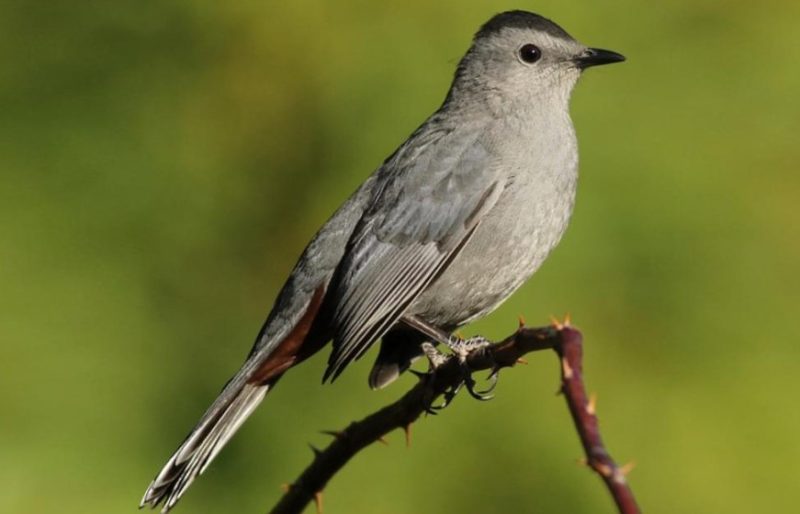
The Gray Catbird is a medium-sized songbird found throughout Vermont during the warmer months. It has a smooth, slate-gray body, a black cap on its head, and a subtle rufous patch beneath its tail. Measuring about 8 to 9 inches long, it has a slender build and a rounded tail that it often flicks expressively.
This bird is a master mimic, capable of imitating the songs and calls of other bird species, as well as mechanical sounds. Its name comes from its most distinctive vocalization—a harsh, cat-like “mew” call. Gray Catbirds are secretive and often stay hidden in dense shrubs or undergrowth, where their varied songs can be heard more than they are seen.
In Vermont, Gray Catbirds inhabit forest edges, hedgerows, overgrown fields, and suburban thickets. They are summer residents, arriving in spring to breed and departing in early fall. These birds thrive in areas with plenty of cover and berry-producing shrubs, which provide both food and nesting sites.
Song Sparrow
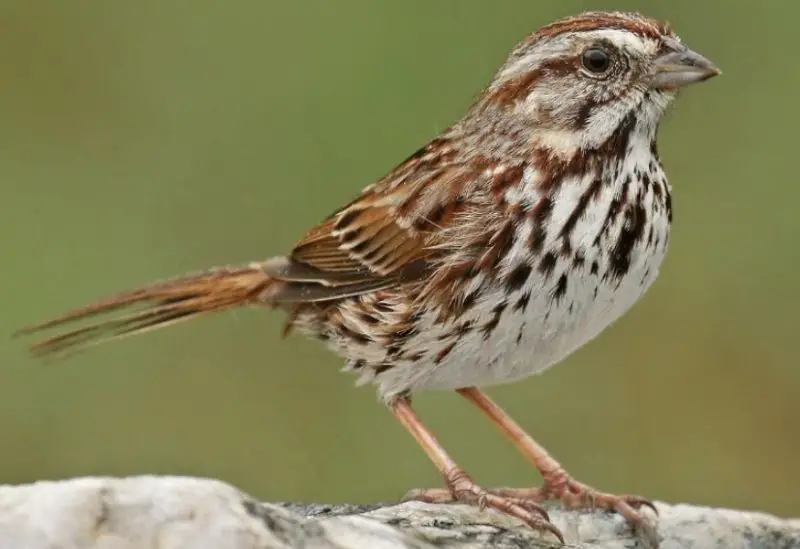
The Song Sparrow is a common and familiar bird in Vermont, easily identified by its heavily streaked brown and white chest with a central dark spot. It has a rounded head, long tail, and warm brown back streaked with black. Adults are typically around 5 to 7 inches in length, with a sturdy, conical bill.
True to its name, the Song Sparrow is celebrated for its sweet, melodious song, often beginning with a few clear notes followed by a jumbled trill. Each bird has a slightly different version, and males sing frequently throughout the breeding season to defend their territory and attract mates. Their calls are also useful for communication between mates and family groups.
These sparrows are widespread across Vermont and are found in a variety of habitats including wetlands, meadows, gardens, roadsides, and forest edges. They are year-round residents in southern parts of the state, while northern populations may migrate short distances south for the winter. They readily visit backyard feeders for seeds, especially during colder months.
Cedar Waxwing

The Cedar Waxwing is a sleek and elegant bird with silky brown and gray plumage, a crest, and a distinctive black mask across its face. Its tail is tipped with bright yellow, and adults often have small red wax-like tips on their wing feathers. Measuring about 6 to 7 inches long, it has a compact body and short, broad bill.
Cedar Waxwings are social and often travel in tight, chattering flocks. Their calls are soft and high-pitched, often described as a thin “see” or “sree” sound. Unlike most songbirds, they eat mainly fruit year-round and are known for passing berries from one bird to another while perched side by side.
In Vermont, Cedar Waxwings are seen in a variety of habitats including woodlands, orchards, riverbanks, and urban parks. They are present year-round, although more abundant in summer when fruit is plentiful. During winter, they roam widely in search of berries and can often be seen feasting on crabapples, mountain ash, and juniper.
Downy Woodpecker

The Downy Woodpecker is the smallest and one of the most widespread woodpeckers in Vermont. It has a black-and-white plumage pattern, with white spots on its wings, a white underside, and a bold white stripe down its back. Males feature a small red patch on the back of the head, while females do not. Measuring about 6 to 7 inches long, it has a short, stubby bill.
Its call is a sharp “pik” and its drumming on trees is relatively soft and quick compared to larger woodpeckers. Downy Woodpeckers forage actively on tree trunks and branches, often hanging upside down while probing bark for insects. They also visit feeders, especially suet and sunflower seed offerings, and can be seen year-round in Vermont.
This species is common in deciduous forests, orchards, parks, and backyards throughout the state. It adapts well to both wild and suburban environments and is often among the first birds to find a backyard feeder, especially in winter when natural food sources are scarce.
Hairy Woodpecker

The Hairy Woodpecker looks almost identical to the Downy Woodpecker but is noticeably larger and has a longer, chisel-like bill. It also sports black-and-white plumage with a white back stripe and spotted wings. Adult birds measure between 9 and 10 inches in length, making them bulkier and more robust than their smaller counterpart.
Its call is sharper and louder than the Downy’s, and its drumming is stronger and more resonant. Hairy Woodpeckers are deliberate foragers, often scaling tree trunks and branches to excavate insects from beneath bark. They’re especially fond of beetle larvae and carpenter ants, making them important in controlling pest populations.
Hairy Woodpeckers are found year-round across Vermont in mature woodlands, forest edges, and wooded residential areas. Though they are less likely to visit feeders than Downy Woodpeckers, they will still come to suet, especially in winter. They prefer larger, older trees for nesting and foraging.
Northern Flicker
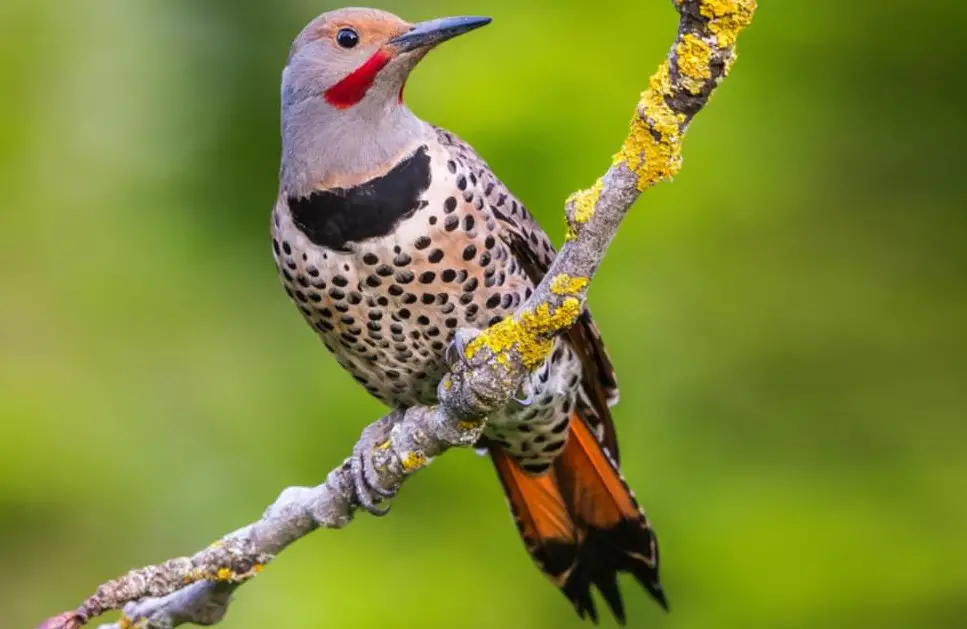
The Northern Flicker stands out among Vermont’s woodpeckers due to its brownish body and distinctive markings. It has a black-barred back, a spotted belly, and a black crescent on its chest. The Eastern population, common in Vermont, shows yellow shafts on the underwings and tail. It measures about 11 to 12 inches long and has a slightly curved bill.
This bird is known for its loud “wick-a-wick-a-wick” call and vigorous drumming on metal surfaces or trees. Unlike most woodpeckers, Northern Flickers often forage on the ground, using their long tongues to lap up ants and other insects. They may also eat fruits and seeds, especially in colder months.
In Vermont, Northern Flickers are commonly found in open woodlands, forest edges, fields, and suburban areas. They are migratory, with most individuals arriving in spring and leaving in fall, although some may stay year-round in southern parts of the state. They nest in tree cavities and occasionally use nest boxes.
Pileated Woodpecker
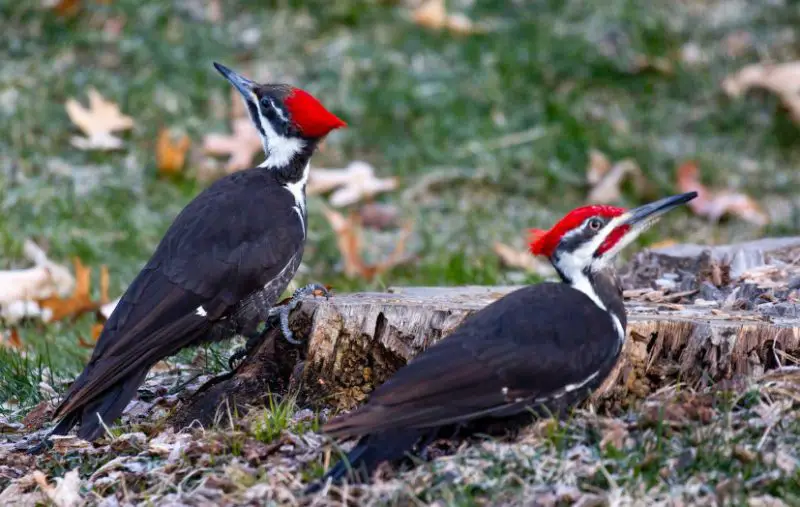
The Pileated Woodpecker is the largest woodpecker in Vermont and one of the most striking woodland birds. It has a mostly black body, white stripes on the face and neck, and a bright red crest atop its head. It measures about 16 to 19 inches long, with a powerful build and long neck. Both sexes share similar markings, though males have a red stripe on the cheek.
Its call is a loud, echoing “kuk-kuk-kuk,” and it produces powerful, slow drumming that resonates through the forest. Pileated Woodpeckers excavate large, rectangular holes in dead or decaying trees in search of carpenter ants and other insects. These holes are often reused by other species after the woodpecker moves on.
Pileated Woodpeckers reside year-round in Vermont’s mature forests, especially those with large, standing dead trees. They prefer deep woodlands but can also be spotted in parks and large wooded suburban lots. Though elusive, their size, distinctive call, and dramatic flight pattern make them an unforgettable sight.
Red-tailed Hawk
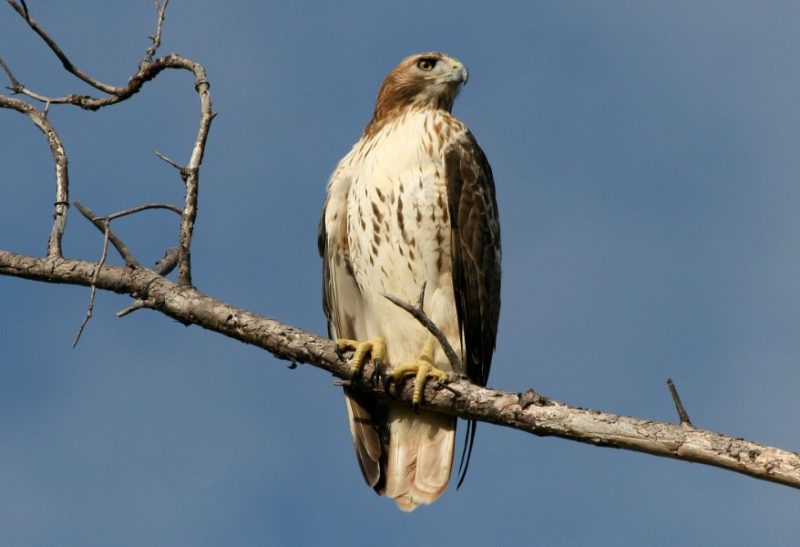
The Red-tailed Hawk is one of the most common and widespread raptors in Vermont. It has broad, rounded wings and a robust body, typically measuring 18 to 26 inches in length with a wingspan of about 4 feet. Its most distinctive feature is the reddish-brown tail, especially visible in adults during flight. The plumage varies but generally includes a streaked, pale chest and a darker back.
This hawk is often seen soaring high above open fields or perched on telephone poles and fence posts. Its call is a distinctive, hoarse scream—“kee-eeeer”—which is frequently used in movies to represent any bird of prey. Red-tailed Hawks primarily hunt small mammals, such as voles and rabbits, using their sharp vision and powerful talons.
In Vermont, Red-tailed Hawks are year-round residents and can be found in a variety of habitats including farmlands, forest edges, and suburban areas. They are commonly observed gliding on thermals or circling above highways. These adaptable birds nest in large trees and occasionally on cliffs or tall structures.
Bald Eagle
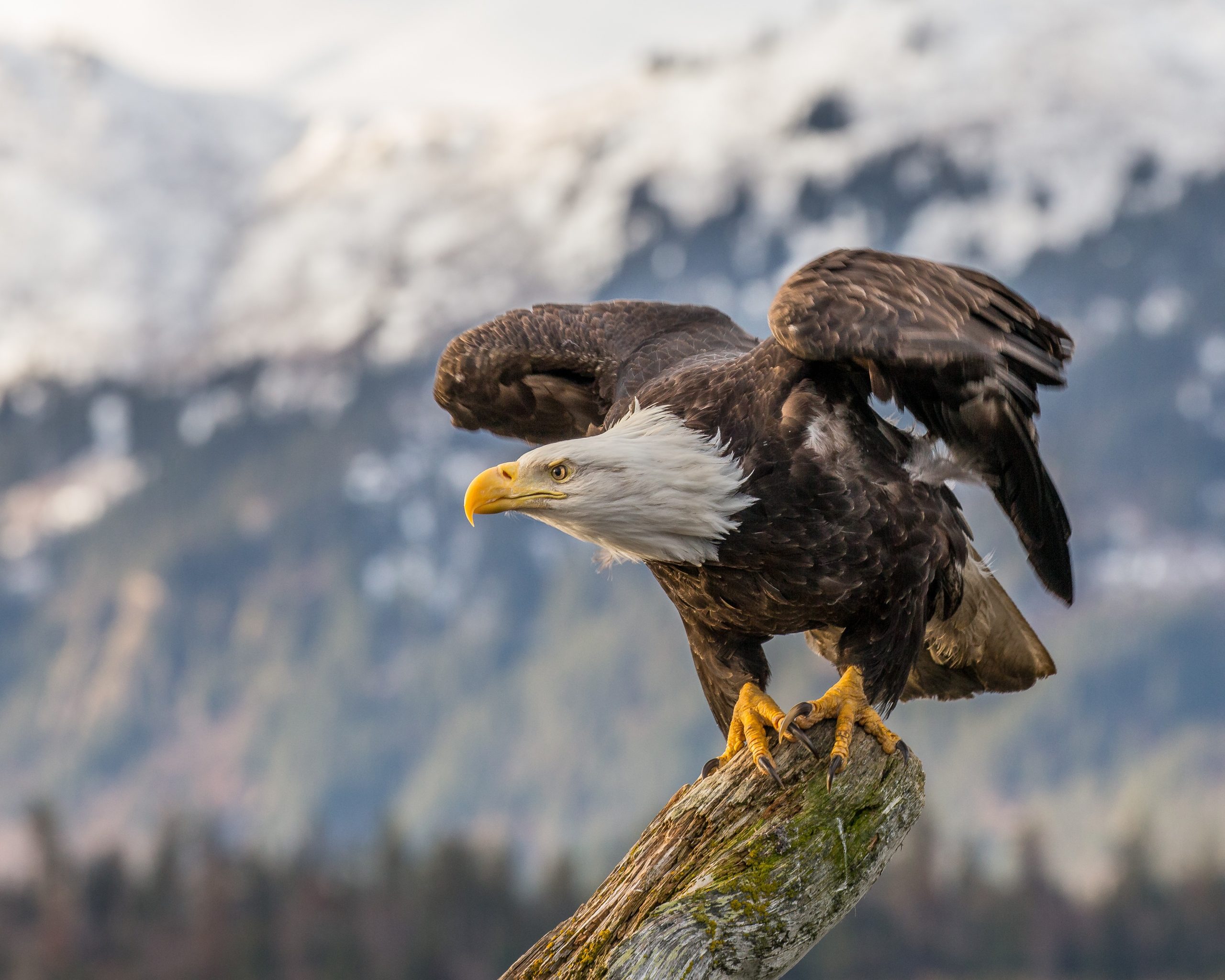
The Bald Eagle, once endangered, has made a strong comeback in Vermont thanks to conservation efforts. Adults are easily recognized by their white heads and tails, contrasting sharply with their dark brown bodies and wings. They are large raptors, measuring up to 3 feet long with a wingspan of 6 to 7.5 feet. Immature eagles are mottled brown and do not develop the iconic white plumage until around age five.
These birds are known for their powerful build and piercing yellow eyes. Bald Eagles have a high-pitched, chattering call, although it’s less dramatic than their visual presence suggests. They primarily feed on fish, using their sharp talons to snatch prey from the water, but also scavenge or steal food from other birds.
In Vermont, Bald Eagles are now regularly seen near large lakes, rivers, and reservoirs, particularly in areas like Lake Champlain and the Connecticut River. They breed near water bodies and return to the same nesting sites year after year. Sightings are most frequent during the warmer months, although some individuals may stay through winter if open water is available.
Osprey
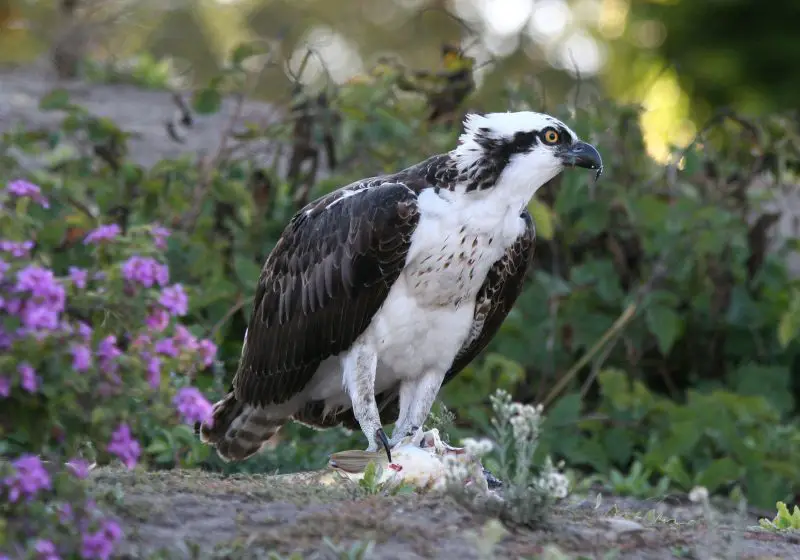
The Osprey is a striking bird of prey often found around Vermont’s lakes, rivers, and reservoirs. It has dark brown upperparts and contrasting white underparts, with a distinctive black eye stripe extending down the sides of its head. Adult Ospreys measure about 21 to 23 inches in length and have a wingspan approaching 6 feet, with long, angled wings.
Ospreys are expert fish hunters and are best known for their dramatic plunge-dives into the water to catch fish with their sharp, curved talons. Their high-pitched, whistling calls can often be heard near their nesting areas. Unlike other raptors, they are almost exclusively piscivorous, meaning fish make up nearly their entire diet.
In Vermont, Ospreys are seasonal visitors, typically arriving in spring to breed and departing by fall. They often build large stick nests on man-made platforms, tall trees, or utility poles near water. Thanks to conservation programs and nest platform installations, the Osprey population has grown steadily in the state.
Barred Owl
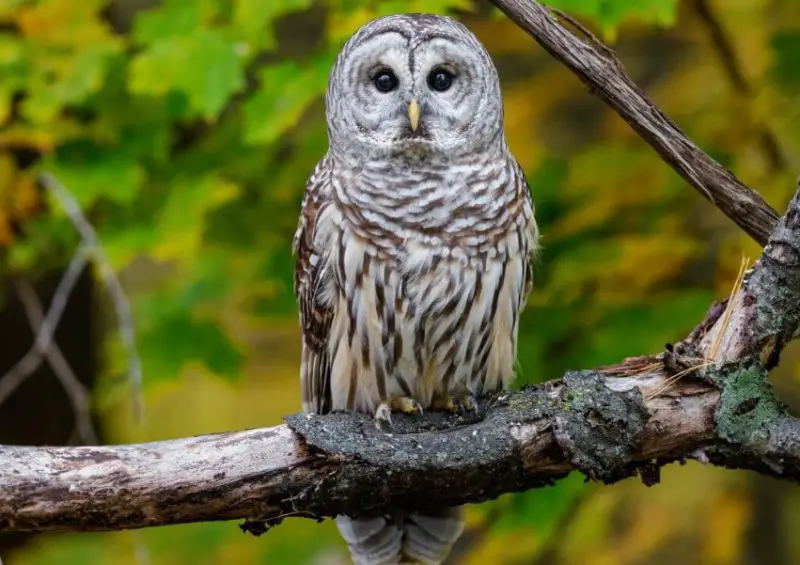
The Barred Owl is a large, nocturnal bird with a rounded head and no ear tufts. Its plumage is mottled brown and white, with vertical brown streaks on a pale chest and horizontal barring on the upper breast, which gives the species its name. Adults measure about 17 to 20 inches in length, with a wingspan of up to 44 inches.
This owl is famous for its haunting and memorable call: “Who cooks for you? Who cooks for you-all?”—a phrase often heard echoing through Vermont’s woodlands at night. Barred Owls are stealthy hunters, gliding silently through the trees in search of rodents, amphibians, and birds. They are most active after dusk and before dawn but may also call during the day.
Barred Owls live year-round in Vermont and favor mature forests near water sources like swamps, riverbanks, or wetland woods. They often roost in dense cover during the day and nest in tree cavities or abandoned nests. Though elusive, their calls and ghostly appearance make them a favorite among nighttime birders and naturalists.
Mallard

The Mallard is one of the most familiar and widespread ducks in Vermont, often seen gliding across ponds, lakes, rivers, and marshes. Males are easily identified by their iridescent green heads, bright yellow bills, and chestnut-brown chests, while females are mottled brown with orange bills. Both sexes have a distinctive blue patch on the wings bordered in white, called a speculum. Adult Mallards measure about 20 to 26 inches in length.
They are dabbling ducks, feeding by tipping forward to reach aquatic vegetation, insects, and small crustaceans in shallow water. Mallards are highly vocal, with the female’s classic loud quack being the most recognizable. Males produce quieter, raspier calls. These ducks are adaptable and frequently gather in large flocks during migration and winter.
In Vermont, Mallards are found statewide and are year-round residents in open water where conditions allow. They breed in wetlands and grassy areas near water and are regular visitors to city parks and backyard ponds. Their ability to thrive in both wild and urban environments makes them a common sight throughout the state.
Great Blue Heron
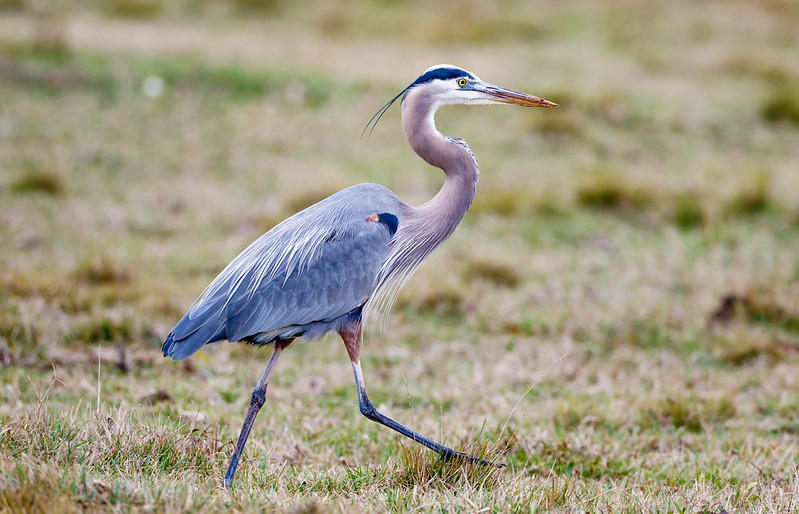
The Great Blue Heron is the largest wading bird in Vermont and is frequently seen stalking the edges of ponds, rivers, and wetlands. It stands about 3.5 to 4.5 feet tall with a wingspan that can exceed 6 feet. It has a long, sinuous neck, grayish-blue plumage, and a dagger-like yellow bill. In flight, it tucks its neck into an “S” shape and beats its broad wings slowly and gracefully.
Great Blue Herons are solitary hunters, feeding primarily on fish, frogs, and small aquatic animals. They stand motionless or move slowly through the water before striking with lightning speed. Their call is a harsh, croaking squawk, especially noticeable when they are startled or in flight.
In Vermont, these birds are common during the warmer months and nest in colonies, often high in trees near wetlands. Though most migrate south for the winter, a few individuals may linger where open water persists. Look for them along the edges of marshes, lakes, and slow-moving rivers, especially in the early morning or evening.
Common Loon
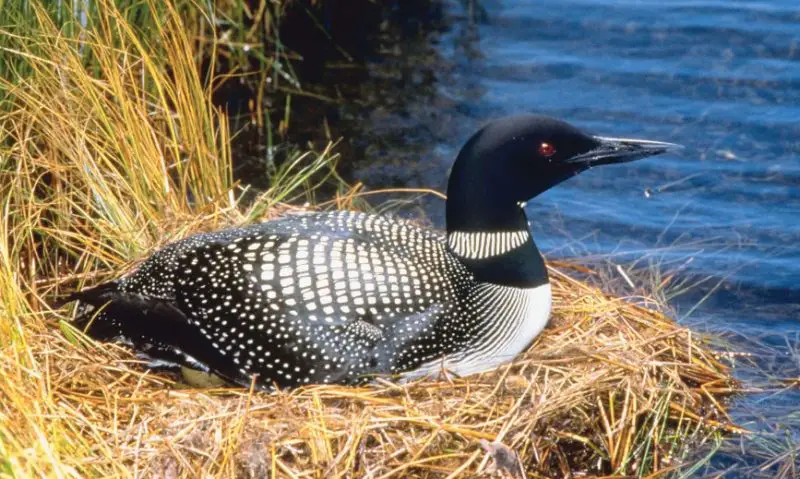
The Common Loon is one of Vermont’s most iconic summer birds, found on quiet northern lakes during the breeding season. It has a striking black-and-white checkered back, a black head, red eyes, and a dagger-like black bill. In contrast, winter plumage is duller gray. Loons are large waterbirds, measuring about 26 to 36 inches long with a wingspan of up to 5 feet.
Known for their eerie and haunting calls, Common Loons produce yodels, tremolos, and wails that carry across lakes, especially at dusk and dawn. These calls serve as territorial declarations and communication between mates. Loons are expert divers, using their strong legs and webbed feet to chase fish underwater.
In Vermont, Common Loons breed on clear, northern lakes with minimal human disturbance. They nest at the water’s edge and are sensitive to shoreline activity. Thanks to conservation efforts, their numbers have been increasing in recent years. In fall, loons migrate to coastal waters, but their summer presence is a cherished symbol of wilderness across the state.
Canada Goose
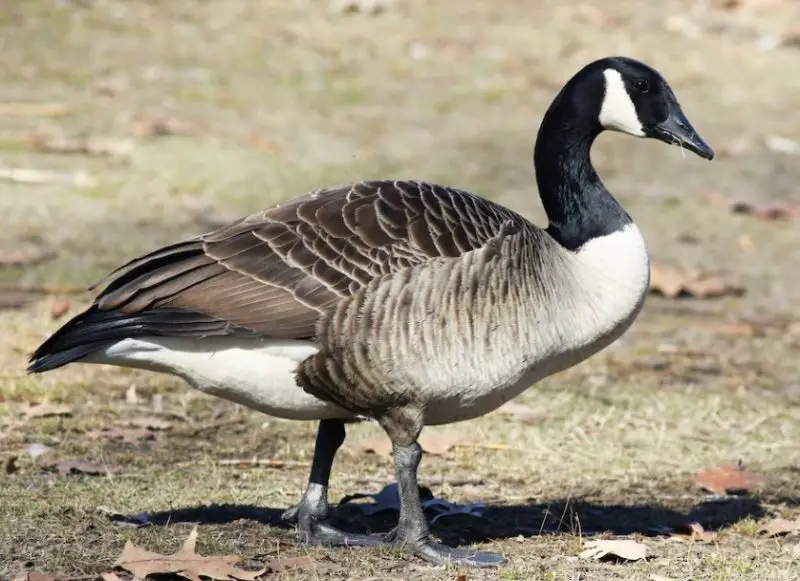
The Canada Goose is a large and highly recognizable waterfowl species that is common across Vermont. Adults have a black head and neck with a contrasting white cheek patch, brownish-gray body, and a white rump. They are hefty birds, typically measuring 30 to 43 inches in length with a wingspan up to 6 feet.
These geese are well-known for their loud, honking calls and their distinctive V-shaped formation during migration. They graze on grasses and grains and often forage in fields, golf courses, and city parks. Canada Geese are highly social and may form large flocks, especially in spring and fall during migration.
In Vermont, Canada Geese are abundant throughout the year, particularly in open fields, wetlands, lakes, and rivers. Many populations are resident year-round, while others migrate through in large numbers. Their adaptability and tolerance for human presence make them a regular sight in both wild and urban settings across the state.
American Goldfinch
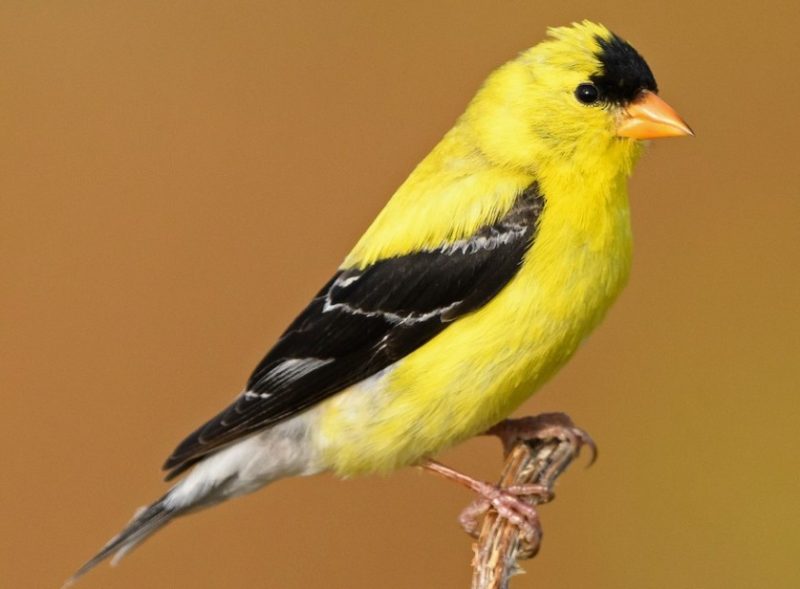
The American Goldfinch is a small, energetic songbird that adds a splash of color to Vermont’s landscapes. In summer, males are brilliant yellow with black wings, a black cap, and a white rump, while females are a duller yellow without the cap. In winter, both sexes turn a more muted brownish color but retain their black wings and white markings. They measure about 4.5 to 5 inches in length.
Goldfinches have a cheerful, twittering song and a distinctive, undulating flight pattern often accompanied by a series of musical “per-chick-o-ree” calls. They are one of the few North American songbirds that molt twice a year and breed late in the season, waiting until thistle and other seed-bearing plants are abundant.
In Vermont, American Goldfinches are common year-round residents, especially in weedy fields, gardens, and open woodlands. They frequent feeders stocked with nyjer (thistle) or sunflower seeds. Their bright summer plumage and bouncy flight make them easy to spot in meadows and suburban backyards alike.
House Finch
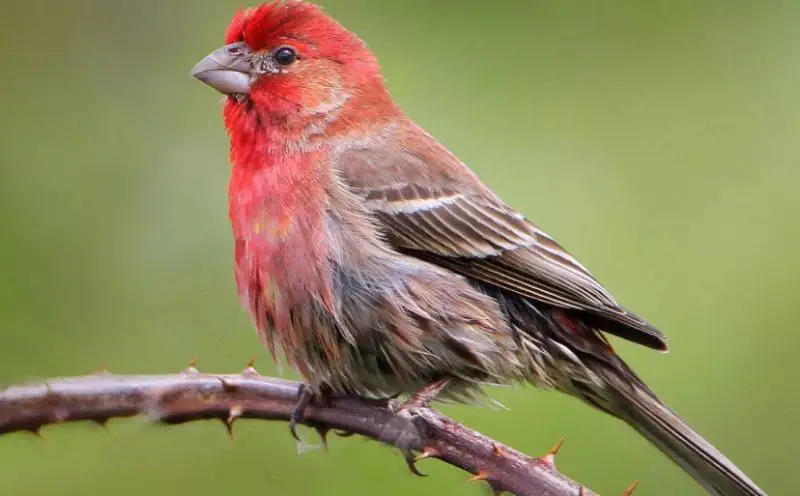
The House Finch is a familiar and sociable bird in Vermont, especially around human habitation. Males have rosy-red plumage on the head, throat, and chest, while females are streaky brown and lack the red coloration. Both sexes have relatively long, slightly curved bills and measure about 5 to 6 inches in length.
These finches are known for their warbling songs and steady, musical chirping. Males often sing from high perches to declare territory or attract mates. House Finches are highly adaptable and feed on seeds, buds, and fruit. They are also frequent visitors to bird feeders, where they gather in small, chatty flocks.
In Vermont, House Finches are year-round residents and are especially common in suburban areas, city parks, and farmland. They build nests in trees, shrubs, and even on ledges and hanging planters. Their strong association with human environments makes them one of the most commonly observed finch species in the state.
White-throated Sparrow
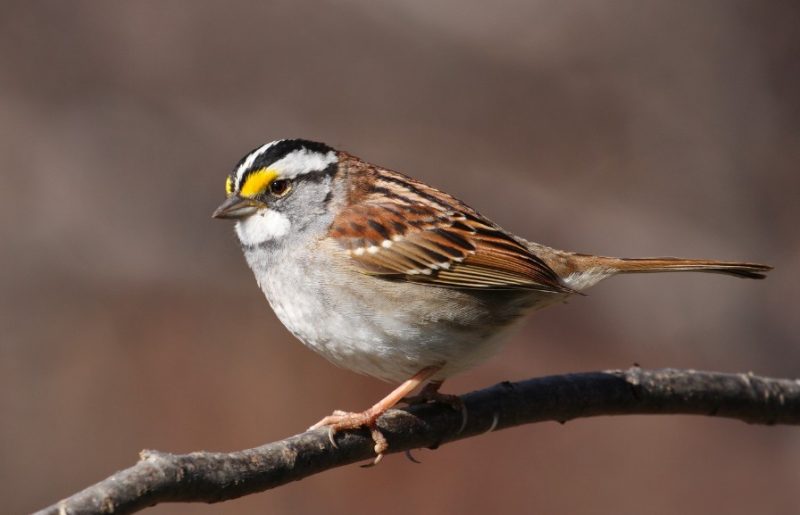
The White-throated Sparrow is a medium-sized, distinctive sparrow often found in Vermont’s forests and thickets. It has a crisp white throat, gray chest, and bold black-and-white or tan-and-brown stripes on the head. A small yellow patch in front of each eye—known as the lores—adds a splash of color to its face. Adults are about 6 to 7 inches long.
This sparrow is well known for its sweet, whistled song, which sounds like “Oh-sweet-Canada-Canada” or “Poor-Sam-Peabody-Peabody,” often heard in the early morning and evening. White-throated Sparrows scratch the ground with a double-hop technique as they forage for seeds, insects, and berries.
In Vermont, White-throated Sparrows are common breeding birds in the northern and higher elevation forests and can also be seen during spring and fall migration throughout the state. They prefer wooded edges, brushy areas, and overgrown fields, where their song adds to the chorus of northern woodlands in spring and summer.

